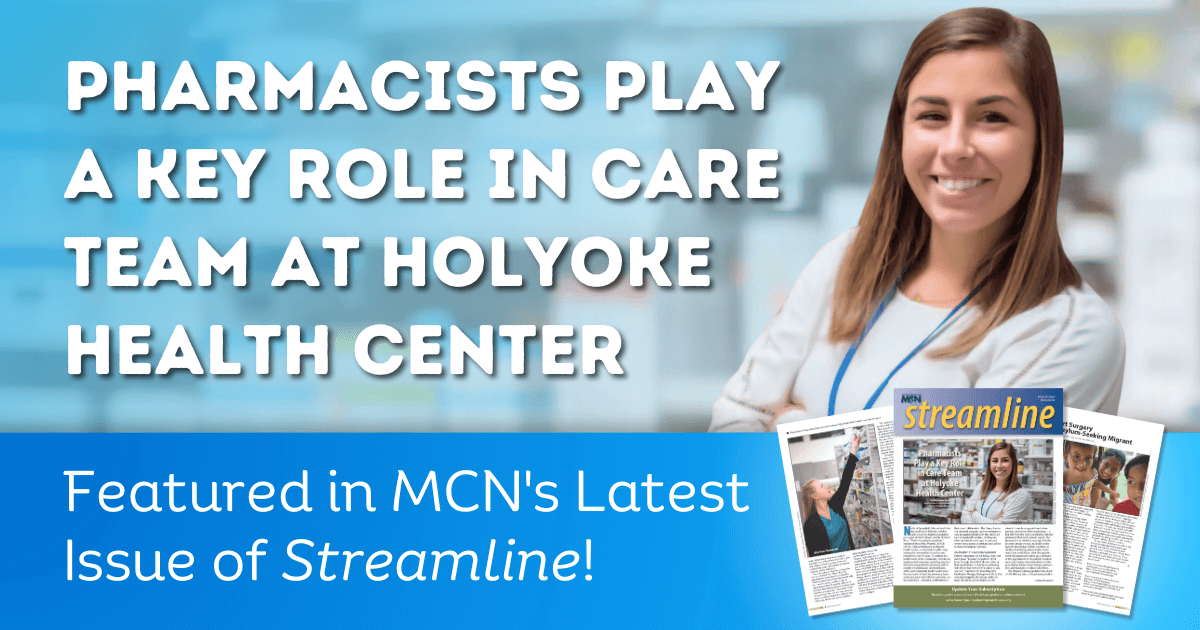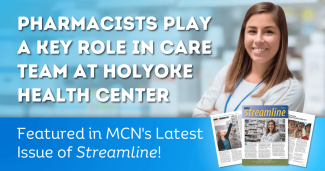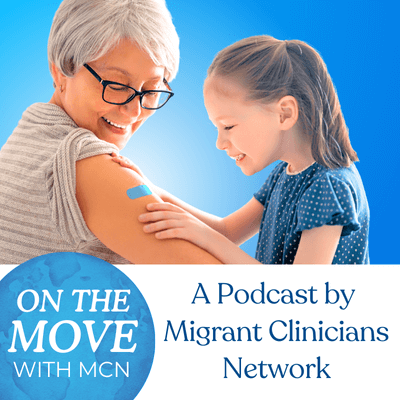Pharmacists Play a Key Role in Care Team at Holyoke Health Center

[Editor’s Note: The winter issue of Streamline is arriving in mailboxes across the US! Here, we reprint the cover article on how one health center brings pharmacists in to advance patient care. This newest issue of our in-print quarterly publication also features articles on the importance of masking during the respiratory disease season, a Health Network case study on finding care for a young asylum seeker who needs heart surgery, and an updated list of resources. Read the entire issue on our Streamline archives page. Streamline is presently available free of charge for subscribers, offering a breadth of articles clinically focused on the health needs and social factors of migrants and farmworkers. You can subscribe to receive Streamline in print here. We are looking for additional members to our Streamline external editorial board. Please contact Claire at cseda@migrantclinician.org for more information on this opportunity.]
North of Springfield, Massachusetts lies the small city of Holyoke, which is said to have the highest population per capita of Puerto Ricans outside of Puerto Rico. “That’s our patient population,” explained Alyssa Puia, PharmD, BCACP, CDCES, Clinical Pharmacist at Holyoke Health Center, a community health center serving the communities in and around Holyoke for over 50 years. To address the health needs of the community, Holyoke has implemented numerous promising practices that have integrated the pharmacy staff of roughly 20 pharmacists and technicians, clerks, and community health workers into the care team. In fact, the pharmacy team works just across the hall from providers, on the same floor – structural confirmation of their close collaboration. The three pharmacist-centered programs and one emergency care program highlighted in this article are rare among health centers, but Holyoke relies on them to close gaps in care and ensure that patients understand and adhere to their prescription regimens.
Medication Therapy Management
Patients sometimes do not follow their treatment plans “because the patients don’t know enough about their disease states or their medications, or they’re experiencing side effects that they haven’t voiced to anyone yet,” confirmed Dr. Puia. Holyoke’s Medication Therapy Management fills in that educational gap by allowing providers to hand off care to a pharmacist for a 30-minute to one-hour appointment where patients get to know their medications – a big shift from the short consultation with the pharmacist that most patients expect. The pharmacist can reinforce messages that the provider already voiced, and build on the patient’s knowledge of their condition, in addition to helping patients better understand their medications. After the appointment, the pharmacist writes up a summary of the appointment in the patient’s medical record and makes recommendations to the prescribing clinician about therapy optimization and strategies to reduce side effects.
The Holyoke patient population has about a 10% illiteracy rate, so the pharmacy built a low-literacy and bilingual packaging strategy that is built into the Medication Therapy Management program. Patients can receive a “med box,” a personalized medication organizer that has each day’s medications separately packaged and labeled for each time of day to take the confusion out of multiple medications. The med box also has a key so that patients can identify the medications in each pill compartment. Holyoke not only packages these medications free of charge, but, because transportation is frequently a barrier, their delivery program also ensures patients receive their weekly packages once a month at no additional cost. During the Medication Therapy Management appointment, the pharmacist can review the med box with the patient to again emphasize the importance of taking each of the medications at the correct time and ensure the patient understands what to do when they get home with their med box.
Transition of Care Service
Another fundamental service at Holyoke focuses on patients who have recently been discharged from the hospital and are transitioning to care at the health center. The health center recognized that patients needed a bridge between inpatient and outpatient care. “Most of the issues that were arising…had less to do with whatever brought them to the hospital, and more to do with problems with their medications – and so it seemed like a pharmacist was the best one to intervene at that point,” Dr. Puia said. This led to the development of the Transition of Care Service. The full-time pharmacist assigned to this program reads the discharge summaries of recently hospitalized patients and meets with them before their upcoming appointment with their primary care provider. Dr. Puia listed out some of the numerous prescription hurdles that this pharmacist can work out. Sometimes, a patient is started on a medication in the hospital as a substitute for a medication in the same class because the hospital doesn’t carry the exact medication of the patient. When the patient leaves the hospital, due to poor health literacy, low literacy, or insufficient communication, the patient ends up taking both medications simultaneously. “That’s an issue. But other times, it’s just they can’t afford the medications that they were prescribed, [or] they don’t understand the role of the meds they were prescribed,” Dr. Puia added. When the patient meets with the primary care provider, these prescription hiccups and barriers are already solved with the pharmacist, allowing the provider and patient to focus their time on a longer-term care plan and getting well.
Collaborative Drug Therapy Management
Dr. Puia primarily works in Holyoke’s Collaborative Drug Therapy Management program, which is possible in Massachusetts due to a law in the state that allows pharmacists to prescribe medication, pursuant to a collaborative practice agreement to treat chronic disease states. “Anything that we discussed with the provider and get a protocol signed off on, we can manage,” Dr. Puia stated. For now, Holyoke pharmacists under this program focus on hypertension, type 2 diabetes, and tobacco cessation, with an eye on future protocols for asthma, hyperlipidemia, and other health conditions. The program launched with hypertension, which was then expanded into diabetes, a large concern in their Puerto Rican community in particular. Nationwide, 12.4% of Puerto Rican adults have a diabetes diagnosis.1
“There’s such a burden of diabetes in this patient population; that, in and of itself, could be a full-time job, so we stayed working with that. We recently added in tobacco cessation because it pairs nicely with the other two disease states,” Dr. Puia added.
In this program, Dr. Puia is paired with a physician, who refers patients to her. The referred patients often have uncontrolled blood pressure or diabetes, or are interested in tobacco cessation. Dr. Puia meets with these patients independently as frequently as she deems fit. “Sometimes in the beginning, especially… if we’re doing insulin titration, it’s every one or two weeks… [to] once a month, while we get their disease state under better control,” she said.
For a patient whose diabetes is out of control, Dr. Puia spends “a lot of time talking to them about different things they’re doing in their life – diet, exercise, those things that influence their control. But a lot of it is… education,” she admitted. “Sometimes, they don’t have a good understanding of their disease state, or the role of the meds, or they have preconceived notions.” She talks with patients about their goals, determining what they would be agreeable to, and together they build a plan that addresses their concerns and works toward their goals. (See sidebar on misconceptions around diabetes.)
Once the patient’s diabetes or hypertension is controlled, she offers follow-up appointments every three to six months, “but they always have that touch point with me – and it’s easier, usually, to get an appointment kind of urgently with me, if they feel their blood pressure or blood sugar numbers are going up,” she noted. Under the protocols, she can also issue prescriptions, or refer the patient to relevant care follow-up, like for eye care or nutrition.
Myths and Misconceptions Around Diabetes
Dr. Puia spends much of her time working with patients whose diabetes is not under control. Some of these patients have refused insulin. “A lot of them have family members that have diabetes, and they’ll say to me, ‘Well, I don’t want to use insulin because my mom had diabetes, she was on insulin,’ and they feel that the bad things that happened to her were because of the insulin,” Dr. Puia explained. Another common myth is that diabetes is genetic; that patients were inevitably going to have it. Both of these issues, Dr. Puia believes, can be addressed by breaking down the myths. “Oftentimes, the bad things happen when diabetes is uncontrolled – and that is coincidentally also when insulin is most used, as it is the most effective medication to control high blood sugars,” she said. “I work to dispel the myths that the bad things happen because of the insulin, instead of because of the disease state.”
Migrant Clinicians Network’s new Misinformation and Disinformation Toolkit features numerous resources and educational articles for providers as well as tools and handouts to share with patients or fellow providers. The online toolkit is available in English and Spanish. Access the toolkit at: https://www.migrantclinician.org/
misinformation-and-disinformation-toolkit-clinicians-and-public-health-workers.html
Pharmacists’ Inclusion in Climate Disaster
Migrant and immigrant communities require health centers to consider emergency plans relating to climate disasters not just in their region, but in the countries from which their migrant populations came. After Hurricane Maria, Holyoke received a strong influx of migrants from Puerto Rico, fleeing disaster. Many left without their medications or medical records, and the health center had no way to communicate with their Puerto Rican health centers or pharmacies, as the hurricane caused much of the infrastructure including the electricity grid to collapse.
“We deployed a team of pharmacists to the floor that were full time, just trying to direct people and understand what disease states they had, and maybe some semblance of what meds they used to be on, so we could bridge them as best as possible from the care they were receiving there, to primary care here,” Dr. Puia recalled. “But it was a hard job.” Many of the above-mentioned programs were put on hold and the pharmacists were pulled into these new patient bridge visits.
Throughout this period, Holyoke’s clinical teams, or “pods,” were seeing roughly 10 new migrant patients a day, in addition to their regular patient panel. As in other areas of Holyoke care, the pharmacist is a key member -- each pod includes a pharmacist. The flow continued for about three months. “We didn’t get back into our usual day-to-day, probably until about six months out,” she recalled.
In anticipation of future disasters, Holyoke providers remind their patients – regardless of where they are from – to keep a list of their diagnoses and medications in their wallet, “so that when you pack up and leave, you’ve at least got the bare minimum,” Dr. Puia said. In the aftermath of the hurricane, Holyoke’s Chief Medical Officer, who is now Holyoke’s Chief Executive Officer, brought supplies and aid to the Island, in hopes of cementing relationships between health centers there and Holyoke, but future Puerto Rican disasters will likely result in similar increased numbers of patients, Dr. Puia said.
Emphasis on – and Trust In -- Pharmacists
Holyoke’s unique pharmacist-centered programs are testament to their dedication to pharmacists – and their commitment goes beyond these programs. Holyoke has a pharmacy residency program, one that Dr. Puia herself completed before signing on to Holyoke as a pharmacist. “A lot of our residents that we train here, they go someplace else, and they bring the kinds of programs that we’re running to other community health centers,” Dr. Puia proudly noted. She says for such efforts to be successful, the organizational support is essential, “but also our providers are so receptive to pharmacy intervention – and that really kind of makes it or breaks it, because they want to work with us,” Dr. Puia emphasized. “They see value in the recommendations that we put forward. They trust us.”
Reference:
1 American Diabetes Association. About Diabetes: Statistics About Diabetes. Available at: https://diabetes.org/about-diabetes/statistics/about-diabetes
Click here for MCN's Streamline page
- Log in to post comments







